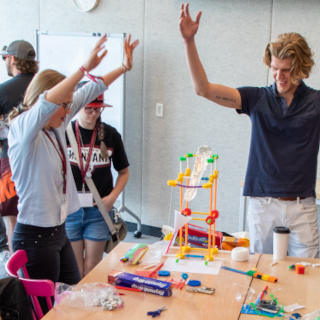Partners in Science
Partners in Science
Through a grant from the M.J. Murdock Charitable Trust’s Partners in Science Program, the University of Montana facilitates paid summer research experiences for science teachers. Mentored by UM faculty members in natural science fields, participating teachers complete a research project over the course of two consecutive summers, with the opportunity to apply for additional Classroom Innovation Grants to extend what they learn in the lab into their classroom teaching. The program includes fully funded travel for teachers to two professional development conferences annually. Current middle and high-school teachers, as well as pre-service teachers preparing for science teaching careers, are eligible to apply.
How do I get involved?
UM’s current Partners in Science initiative launched in summer 2024 and will be recruiting new teacher cohorts to start in the summers of 2025 and 2026. Eligible participants include current middle or high school science teachers with a strong academic background in a natural science field (typically a bachelor’s degree or the equivalent) or pre-service teachers preparing for careers in middle or high school science.
Teachers and pre-service teachers interested in applying, as well as UM researchers interested in serving as mentors, are encouraged to contact Nathalie Wolfram (nathalie.wolfram@umontana.edu).
Meet the 2024-2025 Cohort
Rita Coates (Big Sky High School) is partnering with Dr. Deborah Good (Physics & Astronomy) on astronomy research centered on the role of pulsars (rapidly rotating, highly magnetized neutron stars left behind after the violent supernova death of a medium-sized star) in the search for gravitational waves. Coates will build and refine models for several pulsars and will contribute to ongoing methods development for two upcoming International Pulsar Timing Array dataset releases.
Bryan Ferriter (Big Sky High School) is partnering with Dr. Lila Fishman (Division of Biological Sciences) on research aimed at better understanding the ecological and genetic processes that generate and maintain plant variation at multiple scales, using highly diverse monkeyflowers (Mimulus) as a model system. Specifically, Ferriter and Fishman are testing the hypothesis that Yellowstone thermal monkeyflowers are uniquely cold-tolerant aboveground (leaves) and heat-tolerant belowground (roots), even within the highly diverse Mimulus guttatus species complex.
Brandon Honzel (Big Sky High School) is partnering with Dr. Meredith Zettlemoyer (Division of Biological Sciences) on research quantifying effects of shifting wildfire regimes (decreased intervals between wildfire and reduced time since wildfires) on plant community structure and population dynamics. Honzel is contributing to the Zettlemoyer lab’s collaborative research with the US Forest Service’s Missoula Fire Sciences Laboratory to monitor plant population demography and plant-pollinator interactions of native wildflowers at wildfire-impacted sites in Montana’s Sapphire Mountains.
